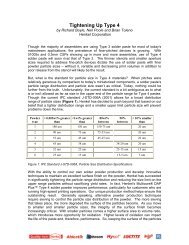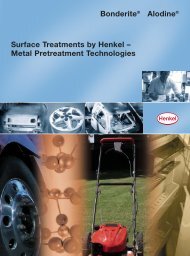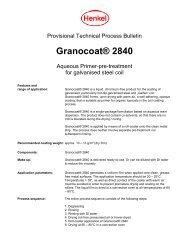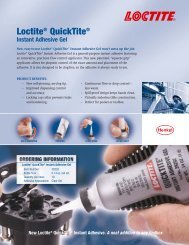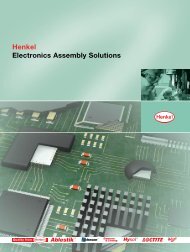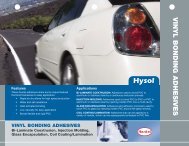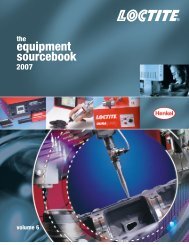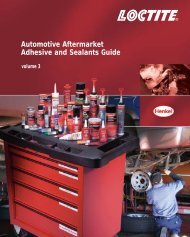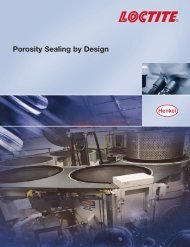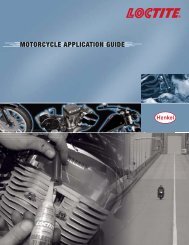SOUND ENGINEERING FROM - Loctite.ph
SOUND ENGINEERING FROM - Loctite.ph
SOUND ENGINEERING FROM - Loctite.ph
- No tags were found...
Create successful ePaper yourself
Turn your PDF publications into a flip-book with our unique Google optimized e-Paper software.
SurroundDust CapGasketConeSpiderGlossary of TermsLead WiresVoice CoilFrameTop PlateMagnetPole PieceCone, also known as a Dia<strong>ph</strong>ragm.Historically, paper has been the cone material of choice, originallyfolded and seamed, but now commonly formed by felting paper pulponto a vacuum mesh die, and steam heated to set it. The density of thepaper is controlled during forming to produce desired characteristics,and varies from very soft and pulpy, to very hard and dense. The specificcomponents in a particular cone paper-slurry are closely guardedsecrets, and this lack of information has created occasional problemsin identification.Since 1980, polypropylene has emerged from numerous potentialnew cone materials, and its success is due in great measure to its lowcost and ease of vacuum forming. More recently, injection moldedpolypropylene has offered improved performance by virtue of variablethickness sections, and is finding widespread acceptance in hi-fi andautosound. The low melting point of polypropylene makes it unsuitablefor high power use however. Other rising stars in the cone materialsarena include glass fiber, carbon "gra<strong>ph</strong>ite" fiber, Kevlar, and Nomexcomposites. Phenolic and epoxy treated cloth have both enjoyed briefpopularity, but have largely been superseded by polypropylene. Somerecent designs have applied aerospace style honeycomb disks in placeof cones, with some success.Conventional cones for tweeters are now rather obsolete, havingbeen replaced by dome shaped cones, which are formed from cotton,rayon, nylon, silk and a variety of other materials such as PET (Mylar),PEI (polyether-imide), PEN (Kalidex), aluminum, titanium, and suchunusual materials as copper and beryllium. Compression drivers, usedon horn type loudspeakers, share much of the dome tweeter topology,although they tend to be somewhat larger in scale.Driver, also known as Loudspeaker or Element.The term driver is used to help differentiate between units whichare raw sound producing elements, and loudspeaker systems, which bydefinition include one or more drivers in an acoustic enclosure. Severaltypes of drivers are outlined below.Woofer, also known as Low Frequency Unit, BassDriver, or Subwoofer.This is the largest of the family of drivers, and producesthe lower tones. Subjected to the lion's share of the inputpower, it is usually the most stressed driver.Midrange, also known as Medium Frequency Unit,Squawker, or Middler.Generally a smaller version of the woofer, the midrange isresponsible for much of the vocal range. It is omitted in 2-way loudspeaker systems.Tweeter, also known as High Frequency Unit, TrebleDriver, or Super-Tweeter.The smallest of the drivers, the tweeter produces thehighest overtones. The voice coil and dia<strong>ph</strong>ragm are alwaysdelicate, and mass is a major concern.Frame, also known as Basket, Chassis, orCone Housing.This is the backbone of a loudspeaker driver, carrying boththe magnet on the rear, and the cone and moving structurein its front cavity. Traditionally loudspeaker frames havebeen punched on multi-stage dies, from cold rolled steelstrip of 0.7 to 1.3mm gauge. They are then plated or painted,and this continues to be the dominant form. Frames arealso cast from aluminum, magnesium, and various engineeringplastics (PBT, ABS, and others), which are gainingwide market acceptance. Frames are typically finished byelectroplating with clear zinc, yellow zinc or in someinstances chromium, or by painting or powder-coating.Dust Cap, also known as Dome, Dust Dome, or Whizzer.The dust cap serves several functions other than the obvious one ofkeeping the gap free of contaminants. It may be a part of the acousticdesign of the driver, serving to radiate high frequencies, or may beused to damp or suppress them, and may contribute structural integrityto the cone and voice coil assembly. Commonly seen as a gentlycurved dome, the dust cap may be mounted in either concave or convexorientations. Or it may have a short, light cone body attached,which is termed a "whizzer" cone, and imparts additional highfrequency output to low cost drivers, where they are often formedfrom Mylar.More typically, dust caps are made from the same materials ascones; hence paper cones tend to get paper dust caps while plasticcones are mated to plastic dust caps, although non-woven felts (hotpressed with polyester resins) are also occasionally used. In the pastfew years, the dust cap has been the object of considerable research.The result of this research has been the introduction of hot-pressedfoam, a variety of plastics in both rigid and flexible forms, and moldedrubber dust caps, all now widely used as acoustic design elements.Gasket, also known as Dress Ring, Trim Ring, or Pad Ring.This seemingly innocuous part serves two distinct functions.Naturally, its primary role is as a gasket, where it allows the driver tomount to a housing without air leakage or buzzes. The second functionis as a covering over the surround to frame bondline, where it servesboth to reinforce the bond and dress it cosmetically. Typically loudspeakergaskets are punched from thick, laminated paper and may beformed in segments, or as a single piece. Both expanded polyetherfoam and polychloroprene rubber have joined the gasket materials ofchoice over the past few years, and include self adhesive backings.Some drivers, particularly those used in the hi-fi industry, are fittedwith injection molded plastic trim rings for product identification andimproved cosmetic value.34




